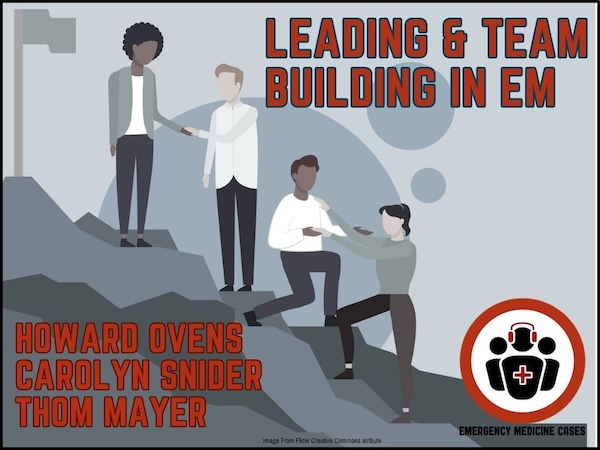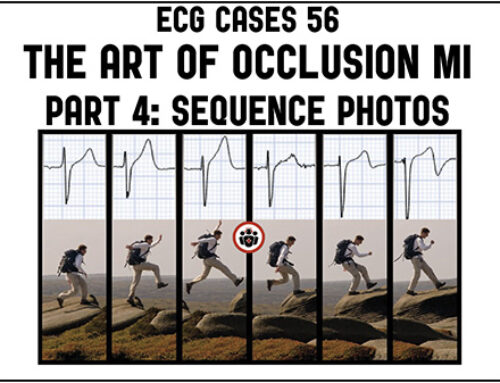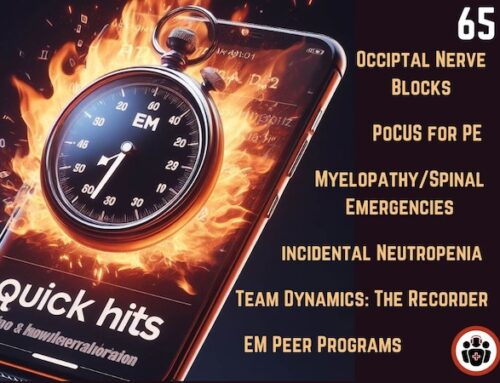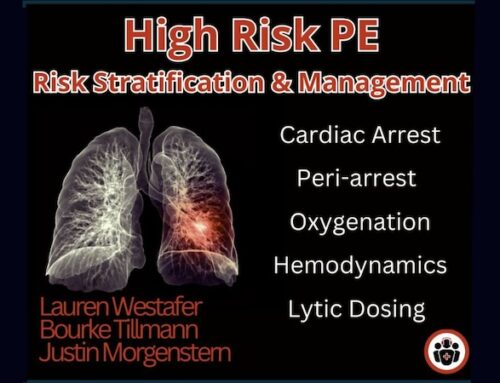Emergency departments operate in a state of near-constant crisis. Whether it’s a hospital-wide IT system crash at 3:00 a.m., a mass casualty event, a string of high-acuity patients, or simply the daily grind of bed block and hallway stretchers, the ED is a crucible. Success depends not just on individual clinical acumen, but on how well we function as teams. Great teams don’t happen by accident — they are built, sustained, and led by people who understand that leadership is not a title, but a way of thinking and behaving. In this EM Cases podcast, we dive deep into what it means to be a leader in EM with three powerhouse voices in Canadian and U.S. EM: Dr. Carolyn Snider, Dr. Howard Ovens, and Dr. Thom Mayer. Whether you’re a veteran staff physician, charge nurse, a resident, or the person holding the door during a trauma code, you are a leader. In this podcast, we cover foundational principles, practical habits, and transformative insights that can make any member of an ED team a more effective, compassionate, and adaptive leader. Here, you’ll find tools, philosophy, and stories that just might transform how you think about your role in the ED to make your work more satisfying, make your teams work together better and improve patient outcomes…
Podcast production, sound design & editing by Anton Helman
Written Summary and blog post by Anton Helman June, 2025
Cite this podcast as: Helman, A. Snider, C. Ovens, H. Mayer, T. Leading from the Inside Out: Building Trust, Teams, and Purpose in Emergency Medicine. Emergency Medicine Cases. June, 2025 https://stg-emergencymedicinecases-emcstaging.kinsta.cloud/leadership-emergency-medicine. Accessed July 3, 2025
We Are All Leaders in Emergency Medicine
Emergency medicine is a team sport. Every team member, from the attending to the triage nurse to the registration clerk, plays a critical role in the delivery of care. And because EM is team-based, every team member has the capacity and responsibility to lead. This kind of leadership isn’t tied to hierarchy or titles. Instead, it starts with leading yourself: showing up prepared, rested, and present. It extends to leading your peers through support, communication, and shared responsibility. And it culminates in contributing to a culture where every person feels valued and empowered to do their best work. Leadership, in this sense, is not a future aspiration. It’s a current responsibility. Whether you’re leading a resuscitation or stepping up in a hallway conversation, you’re shaping the culture and flow of your ED. You’re leading.
“The leader you’re looking for is you.” – Dr. Thom Mayer
Leadership Is Not a Title — It’s a Verb: Leadership vs Leading
There’s a big difference between leadership and leading. Leadership is something people talk about; leading is something you do. We all know the type — someone who wants the role, the office, the nameplate — but hasn’t inspired, empowered, or supported anyone around them. Leadership is often conceptualized as a role, a job title, or a position of authority. But leading is a verb. It’s what happens when someone steps up to take initiative, to inspire others, to ask the right question, or to admit a mistake. Leading is actionable, constant, and deeply personal. Emergency medicine is full of moments that call for leading: coordinating a code, de-escalating an agitated patient, advocating for a hallway patient who has waited hours, or simply making space for a junior colleague to speak up. Leading in these moments means acting with purpose and integrity, regardless of formal recognition.
Many people mistakenly believe leadership is reserved for a special few who were born with the right traits. But true leadership is practiced, learned, and refined through experience. And in Emergency Medicine, the best leaders are often those who have spent years on the ground, listening, reflecting, and adapting. Leadership also requires followership. The ability to support others, defer when appropriate, and empower colleagues is just as important as directing or delegating. True leaders know when to lead and when to follow. The best teams are those in which leadership flows dynamically, not rigidly.
Creating Psychological Safety in the Emergency Medicine
An effective ED team creates a space where people feel psychologically safe to contribute, to challenge, and to innovate. One of the most powerful ways to do this is by sharing leadership. In a resuscitation, for example, the designated leader sets the tone, but should also actively encourage input. When a nurse suggests an alternative airway plan or a resident recommends a novel intervention, the leader must be open to those ideas. Leadership means inviting contribution, not dictating orders. Creating this kind of environment helps all team members perform at their best and ensures that patients receive the highest quality of care. Leadership style varies, but authenticity is non-negotiable. Some lead with quiet confidence, others with focused intensity. What’s critical is that the style is genuine. Creating a calm, respectful atmosphere often involves small but powerful habits: introducing oneself as the team leader, setting expectations for quiet communication, acknowledging each person’s role, and using clear, polite language. These habits set the tone and elevate performance.
Understanding That Emergency Departments are ‘Modern-day Sanctuaries’ to Inform Leading
The ED can be considered a modern-day sanctuary. It never closes. It welcomes people at their most vulnerable, on their worst days, often when every other system has failed them. That sanctuary role demands compassion, adaptability, and a deep respect for the trust that patients place in us. Sometimes we save lives; sometimes we offer socks and a sandwich. Both acts are part of the same calling. This identity shapes how we should lead. It requires us to bring not only clinical skill, but emotional intelligence and humility. It also calls on us to foster a culture where every team member sees their work as part of this broader mission.
Trust as the Foundation of Leadership
Trust is the foundation of effective leadership. It’s what enables people to take risks, share ideas, admit mistakes, and try new approaches. Trust doesn’t happen through speeches or mission statements; it is built through consistent, day-to-day actions:
- Being on time
- Acknowledging good work
- Following through on promises
- Admitting when you’re wrong
- Listening attentively
- Being kind
Trust is also built by staying grounded in our shared purpose: caring for people. And when trust exists, teams become more innovative, more resilient, and more united.
“Innovation doesn’t happen at the speed of genius. It happens at the speed of trust.” – Dr. Thom Mayer
Deep Joy, Purpose, Vision and Meaning in Emergency Medicine to Strengthen Teams
Burnout is often described as emotional exhaustion, depersonalization, and a sense of ineffectiveness. But at its core, burnout is the inability to feel joy in the work you once loved. Reconnecting with “deep joy” — that intersection between what you love and what the world needs — is essential. In EM, that deep joy might come from cracking a tough diagnosis, supporting a grieving family, or mentoring a junior colleague. Leaders must help their teams rediscover that joy. Not through cheerleading, but by removing barriers, creating space for meaningful work, and recognizing small victories. Create a shared vision and purpose for your team that isn’t just about flow and metrics — but about why we’re here.
“Self-interest is hostile to the common good, but enlightened self-interest is not.” – Alan Bloom
“He who has a why to live can bear almost any how.” – Friedrich Nietzsche
Mentorship and Role Modeling in Emergency Medicine Leadership
Mentorship is a cornerstone of leadership. Everyone needs multiple mentors and be an effective mentor to others. We all benefit from having people who see our potential, who challenge us to grow, and who model the kind of leader we aspire to be. Being a good mentor requires more than giving advice. It means asking good questions, offering honest feedback, and being willing to share your own failures. Mentors don’t just shape careers; they shape confidence and adaptability. In the same way, role modeling matters deeply. Every act of kindness, every calm de-escalation, every fair shift trade, models the kind of leadership that sticks with people for years. If we want to build a new generation of adaptive, compassionate, and courageous emergency providers, mentorship and role modeling become everyday habits — not an occasional favour.
“We are what we repeatedly do. Excellence, then, is not an act but a habit.” –Aristotle
Communication, Listening, and the Power of Silence
Listening is the most important aspect of effective communication. Emergency providers are notorious for interrupting patients within seconds. But listening — truly listening — is one of the most powerful leadership tools. Listening builds trust. It shows respect. It uncovers vital information. And it creates space for others to feel seen and heard. Silence can be just as powerful as impactful statements. In a chaotic ED, pausing to think, to reflect, or to allow someone else to speak up creates opportunities for better care and stronger relationships.
Adaptive Capacity: An Alternative to Resilience
The term resilience is often used to describe what EM providers need. But resilience can feel individualistic, even ‘blamey’. A better concept for team building is adaptive capacity: the ability to adjust to changing demands while staying grounded in purpose. Adaptive capacity isn’t just about bouncing back. It’s about knowing yourself, managing stress, and adjusting your style based on the needs of the moment. It means preparing for uncertainty, staying curious, and being willing to change course. We need to adapt, not just in how we manage patients, but in how we listen, communicate, and recover.
The Role of Integrity in EM Leadership
Integrity is essential to leadership. It’s about aligning your actions with your values. It means doing the right thing, even when it’s hard, and especially when no one is watching. In the ED, integrity is noticed quickly. We’re all under a microscope in the ED. If we say one thing and do another, we lose credibility. Nothing undercuts moral authority like hypocrisy. If your words and actions don’t match, people will stop trusting you. If you make mistakes and never own them, your credibility erodes. Leaders with integrity own their decisions, apologize when needed, and remain humble in the face of uncertainty. They also know how to laugh at themselves, embrace imperfection, and model self-awareness. Encourage yourself to understand your own emotional triggers. When we know what makes us feel threatened, we can lean into discomfort and grow.
Creating Shared Vision and Purpose as a Leader in Emergency Medicine
High-performing teams have shared purpose. It doesn’t have to be formal or complicated. It can be as simple as: “We are here to provide compassionate, expert care to everyone who walks through our doors.” Leaders create vision by asking questions: What makes you proud to work here? What do we do well? What could we do better? These questions help define the culture, goals, and collective identity of a team. Empowerment is about giving people control, especially in times of chaos. During the COVID pandemic, for example, some departments thrived because everyone was invited to lead. Physicians, nurses, and allied health professionals were asked to take on micro-leadership roles — whether that meant innovating PPE strategies or developing compassionate palliative care protocols. When people are empowered, they take ownership. And when they feel recognized, they stay committed. Empowerment and recognition together create a culture of pride and accountability. If you want to build a strong team, make people feel important. Not just with pay or titles, but by giving them ownership. Empowerment builds adaptability. Autonomy builds pride.
“Always the more beautiful answer who asks the more beautiful question.” – e.e. cummings
Handling Team Breakdowns
No team functions perfectly all the time. There will be breakdowns and conflicts. Moments when trust is lost or people feel unsupported. When teams falter, leaders must be present, visible, confident and humble. They should acknowledge the strain, admit uncertainty, listen without defensiveness, and chart a path forward together. Walk with your team, not above them.
Key principles in managing the breakdown of a team:
- Identify the seams (where teams intersect: nurse-physician, tech-clinician, ED-consultant) where communication or trust broke down
- Rebuild trust through open dialogue
- Support individuals who are struggling
- Reaffirm the shared mission
Key Take Home Points from Leading from the Inside Out: Building Trust, Teams, and Purpose in the Emergency Department
Leadership in Emergency Medicine is not about the official position you hold in your ED. It’s about what you leave behind at the end of each shift. You leave a sort of legacy with every interaction: The resident you debriefed with care, the nurse you thanked for flagging an abnormal test result, the family you comforted in the hallway. These moments matter. They help define your leadership. And over time, they help shape the culture of your ED.
- Leadership ≠ title: Leading is about action, not designation. We are all leaders.
- Trust builds teams: Be consistent, kind, and honest.
- Vulnerability is power: Show it to foster connection.
- Purpose matters: Reconnect with your deep joy that attracted you to EM in the first place.
- Adapt every day: Build your adaptive capacity.
- Culture lives in small moments: How you greet, thank, and listen.
References
- Mayer, T. (2024). Leadership is Worthless. . .But leading is priceless: What I Learned from 9/11, the NFL, and Ukraine. Berrett-Koehler Publishers.
- Ovens, H. WTBS 30 Lessons on EM Leadership: The Role of the Leader [blog]. Toronto, ON: Emergency Medicine Cases; 2024. Available from: https://stg-emergencymedicinecases-emcstaging.kinsta.cloud/lessons-emergency-medicine-leadership-role-of-leader/
- Ovens H. WTBS 29 Four key learnings from a career in emergency medicine leadership [blog]. Toronto, ON: Emergency Medicine Cases; 2024. Available from: https://stg-emergencymedicinecases-emcstaging.kinsta.cloud/emergency-medicine-leadership/.
- Drucker, P. F. (2011). HBR’s 10 Must reads on Leadership. https://digilib.ubd.ac.id/index.php?p=show_detail&id=8263
- Enlightened self-interest. San Francisco, CA: Wikimedia Foundation Inc; 2024. Available from: https://en.wikipedia.org/wiki/Enlightened_self-interest.
- Bloom, A. (2008). Closing of the American mind. Simon and Schuster. pg 167.
- Beckman HB, Frankel RM. The effect of physician behavior on the collection of data. Ann Intern Med. 1984 Nov;101(5):692-6.
- Redelmeier DA, Molin JP, Tibshirani RJ. A randomised trial of compassionate care for the homeless in an emergency department. Lancet. 1995 May 6;345(8958):1131-4.
- Vaillant, G. E. (2012). Triumphs of experience. Harvard University Press.
Drs. Helman, Snider, Mayer and Ovens have no conflicts of interest to declare





Leave A Comment